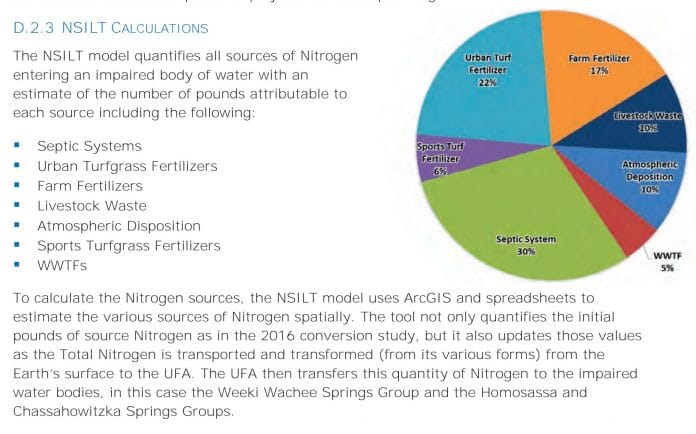At the regular meeting on June 9, 2020, Commissioners voted unanimously to accept the “Wastewater Treatment Feasibility Analysis Report” which outlines septic-to-sewer conversion, and other nitrate mitigations projects over the coming decades. The projects seek to mitigate nitrogen and other nutrient introduction into the local springs and aquifer, as well as the Gulf of Mexico.
Presented by Utilities Director Gordon Onderdonk, the scientific study began in accordance with a Senate Bill 552, the “Florida Springs and Aquifer Protection Act” signed into law in July of 2016, which requires that Priority Focus Areas (PFAs) be established and remediation plans developed for all Outstanding Florida Springs. The plans are required for PFAs with greater than 20% nitrate contribution from septic systems.
Hernando County includes two such PFAs, the Chassahowitzka Spring north of Centralia Road and the Weeki Wachee Spring PFA, which extends from Centralia Road south to County Line Road. These areas are within the two like-named BMAPs (Basin Management Action Plans), however are a subset of them.
The county has received grant funds to facilitate these projects, however, a gap exists that will likely affect property owners. In September 2019, Onderdonk reported a 20% funding gap that would have to be paid for by the residents.
Onderdonk said (in Sept. 2019), “These projects initially started out at about $25,000 per house. It looks like it will be upwards of $30,000 per house. So I want to let you know that 20% is about $6000 that the resident will be responsible for, even though we would be providing 80% of the funding through these other agencies and the utility.”
Discussion began with Commissioner John Allocco, who asked the bulk of the questions about the methodologies and interpretations of the study. Allocco first asked how often the Weeki Wachee springs were being tested for nitrates. With the data not immediately at hand, Onderdonk explained that the frequency has increased in recent years. Allocco requested that the board be provided this information on a regular basis. “It’s very convenient to do a test, and set up policy, and now we’re stuck trying to deal with that policy.”
According to the study, septic systems contribute 30% of the nitrogen introduced to the Weeki Wachee Springs, along with fertilizers. Of the fertilizer contributions, urban turf fertilizer contributes 22% and farm fertilizers, 17%.
Commissioner John Mitten was the first to ask how many farms are contributing that much, since area farms are located at considerable distance from the waterways. Onderdonk answered that the farm fertilizer runoff affects surrounding waterways that eventually come into contact with the springs.
Allocco, following Mitten’s thought said, “Any farmer that I’ve spoken to uses the absolute minimum amount of fertilizer necessary because there’s such a fine, razor sharp edge for profit and ‘not profit.’ And, I don’t see anybody using any kind of measurement when they’re urban turf fertilizing… I just struggle with these numbers because I think they’re bogus. I can’t imagine that farm fertilizers are causing 17% (of the nitrogen contribution). I just can’t believe it. I guess I’m just a skeptic at heart but I’m telling you farmers aren’t wasting anything.”
Commissioner Jeff Holcomb asked Onderdonk how the types of fertilizer could be differentiated during testing. Onderdonk explained that the study was conducted using a computer modeling program called “Nitrogen Source Information Loading Tool” or NSILT.
County Administrator Jeff Rogers commented on the tools and methods and said “I will tell you there’s enough science to prove that it’s unfortunate — but that there’s nothing (underground that attracts nitrates, or traps them) so it does travel. Now the question is how long it takes for that nitrate to get there?”
More information on NSILT: https://www.arcgis.com/apps/MapJournal/index.html?appid=e71ecaa35bdd4caaba7a0c411691dfa7

